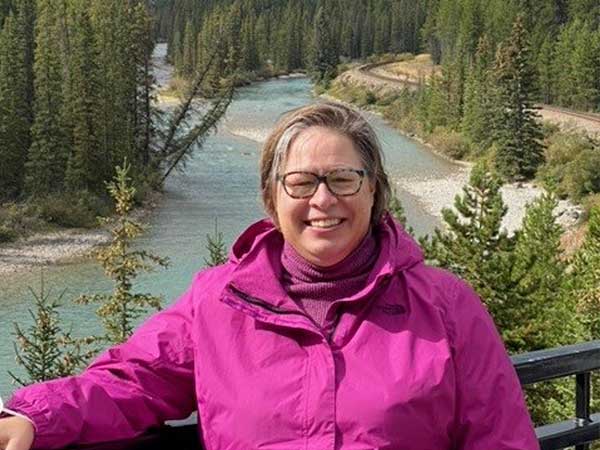in Chatsworth, Grey Highlands, Southgate, West Grey
March 01, 2023

BY JOHN BUTLER — Jennifer Stephens, General Manager of the Saugeen Valley Conservation Authority (also known as Saugeen Conservation), loves water. She loves the rivers that water flows into, and she loves the lands nourished and drained by these rivers.
These are all the right makings for someone who manages a conservation authority covering the multi-branched Saugeen River watershed that covers 4,675 square kilometres in Grey, Bruce, Dufferin, Huron and Wellington counties — one of 36 conservation authorities in Ontario.
Stephens will share her passion for the worth of water and the importance of conservation, as part of her free public presentation entitled A Primer on Conservation Authorities, to be held at the Kimberley Community Hall on Wednesday, March 8 at 1:45 pm. The Hall is at 235309 Grey Rd 13 in Kimberley. Everyone is welcome, the building is wheelchair-accessible, and no registration is required. The event is sponsored by the Grey Highlands Probus Club, the Kimberley Community Association, and the Grey Highlands Public Library.
Joining the Saugeen Valley Conservation Authority as its General Manager in June 2020, at the height of the COVID epidemic, Stephens acknowledges her staff with orientating her, and for continuing to problem-solve with their community, under trying circumstances.
Stephens grew up in Ottawa and credits her park-rich hometown and its adjacent Gatineau Hills and Ottawa River watershed for sensitizing her to what became her life’s work. Her youthful experiences through the Girl Guides of Canada and as a participant in the Duke of Edinburgh Award Program further led her to an appreciation of the natural world. She originally studied life sciences at the University of Western Ontario (UWO) with the intention of becoming a physiotherapist, but her fourth year at UWO exposed her to botany and zoology in depth, refining her career path. She then completed graduate work at Queen’s University that qualified her as an aquatic scientist and water quality specialist.
Her first job following graduation was water quality work for the South Nation Conservation Authority in Eastern Ontario, a position that allowed her to become adept in French as well as English. There followed a series of positions with conservation authorities responsible for both urban and rural watersheds across Ontario.
Stephens maintains that the public has good reason to learn what conservation authorities do, and why they do it. Expanded greatly in the 1950s, in the aftermath of the devastation caused in Ontario by Hurricane Hazel in 1954, conservation authorities have been in the hazard management business from the very beginning — hazards that will threaten us even more as human induced climate disruption continues and increases. Windstorms, shoreline erosion, water quality changes, flooding and more frequent and severe weather events all pose dangers, and the more we understand these dangers and how to protect our communities from them, the safer we will be — and conservation authorities are at the forefront of community, property and environmental protection.
Stephens points out too that each conservation authority is organized to cover a specific watershed, and a watershed crosses many municipal boundaries. This means that a conservation authority must work in partnership with many municipalities to deliver services that further the conservation, restoration and management of its watershed and water resources. Saugeen Conservation, for instance, covers parts of 15 municipalities, all of which are represented on the Authority’s Board. Any citizen interested in how local government serves them should also be interested in how their conservation authority serves them.
When asked to identify her own 'watershed moments' — occasions when her commitment to conservation was heightened — Stephens first identified the Walkerton water crisis of May 2000, in which water safety provisions were breached, leading to an E. coli outbreak that caused the deaths of seven people and 2,300 illnesses in the town — and that led to improvements in Ontario’s water protection laws. She then identified, as a watershed moment, the passage of Ontario’s Bill 23 (the More Homes Built Faster Act, 2022) an act that has resulted in changes to many laws, including environmental legislation, in an attempt to provide housing.
Jennifer Stephens and the event sponsors welcome the public to attend this free primer on conservation authorities. If you attend, they say, you will never think of water and conservation the same way again.
At South Grey News, we endeavour to bring you truthful and factual, up-to-date local community news in a quick and easy-to-digest format that’s free of political bias. We believe this service is more important today than ever before, as social media has given rise to misinformation, largely unchecked by big corporations who put profits ahead of their responsibilities.
South Grey News does not have the resources of a big corporation. We are a small, locally owned-and-operated organization. Research, analysis and physical attendance at public meetings and community events requires considerable effort. But contributions from readers and advertisers, however big or small, go a long way to helping us deliver positive, open and honest journalism for this community.
Please consider supporting South Grey News with a donation in lieu of a subscription fee and let us know that our efforts are appreciated. Thank you.